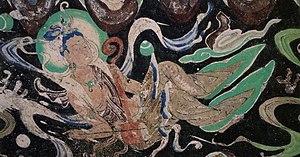Xiqin (instrument)

The xiqin (Chinese: 奚琴; pinyin: Xī qín) was a bowed 2-string string musical instrument.[1] The instrument was called xiquin in China, referencing the Xi (the creators, a Mongol tribe) and quin (Chinese for stringed instrument).[2] It is perhaps the original member of the huqin family of Mongolian and Chinese bowed string instruments; thus, the morin khuur and erhu and all similar fiddle instruments may be said to be derived from the xiqin.[2] The xiqin had two silk strings and was held vertically.
Origin and development
[edit]The xiqin is believed to have been developed by the Kumo Xi, a Mongol- or Khitan-related ethnic group living in the Xar Moron River valley in northeast China.
The xiqin first appeared in China during the Tang dynasty (618–907 CE), during which time it was used in the palace orchestra and bowed with a bamboo stick.[2] It was further developed in the Song dynasty (960–1279), when it began to be bowed with a horsehair bow.
In 1105, during the Northern Song dynasty, the instrument was described as a foreign, two-stringed fiddle in an encyclopedic work on music called Yuè Shū (樂書; literally "book of music") by the music theorist Chen Yang (陳暘).
Similar instruments
[edit]The erxian used in nanguan music and the kyl kiak used in kuu music of Kyrgyzstan is similar in construction to the xiqin. The Korean haegeum (Korean: 해금; Hanja: 奚琴) is also very similar in shape to the xiqin from which it is derived; in fact, its name is simply the Korean pronunciation of the same Chinese characters. The Chinese characters in Cantonese would be hai kum which shows that the name in Middle Chinese would probably sounds more like Cantonese or Korean rather than the current Mandarin transliteration; however, the Mongolian khuuchir or khoochur is seen as directly related to the etymology of Old Chinese, which is retained in the modern Mandarin example of huqin or huchin, which is the general description of all spike-fiddles which originated with the ancient nomadic Hu-people, including the xiqin.[3][4]
See also
[edit]References
[edit]- ^ Sadie Stanley, ed. (1984). "Xquin". The New Grove Dictionary of Musical Instruments. Vol. 3. London: MacMillan Press. p. 868.
Xiqin. Historic two-string fiddle of China.
- ^ a b c Sadie Stanley, ed. (1984). "Erhu". The New Grove Dictionary of Musical Instruments. Vol. 2. London: MacMillan Press. p. 787.
Erhu...early ancestor known as xiquin...xi; a northern tribe known to the chinese; quin: 'string instrument'...two strings which were set in vibration with a strip of bamboo...
- ^ "Introduction of Traditional Chinese Bowed String Instrument - Erhu, Gaohu, Zhonghu, Banhu, Chinese Violin, Chinese Fiddle". Archived from the original on 2012-01-12. Retrieved 2015-04-08.
- ^ "Talk about Horse-head Fiddle of the Mongolians_Learn Chinese Hujiang".
External links
[edit]- "[松原文化]马头琴的传说郭尔罗斯远古的神话[松原信息港]". Archived from the original on July 7, 2011. Retrieved April 7, 2010.
[note: this source relates a legend of the creation of another Mongolian fiddle, as if it were the first of its type.. It does not mention the xiquin by name.] This is consistent with the time when the horse-head fiddle itself was produced...the Gorlos tribe was the pioneer tribe of the Mongolians' "smelting iron out of the mountains" (i.e. "melting iron out of the mountains"), and took the first step to liberate themselves. The Mongolian tribe was the most advanced tribe, and it had the foundation for the myth of the horse-head fiddle.
